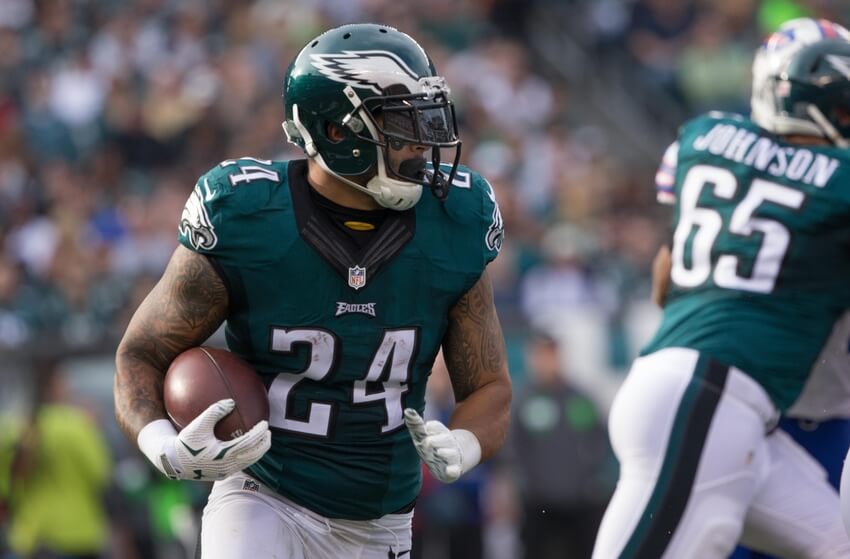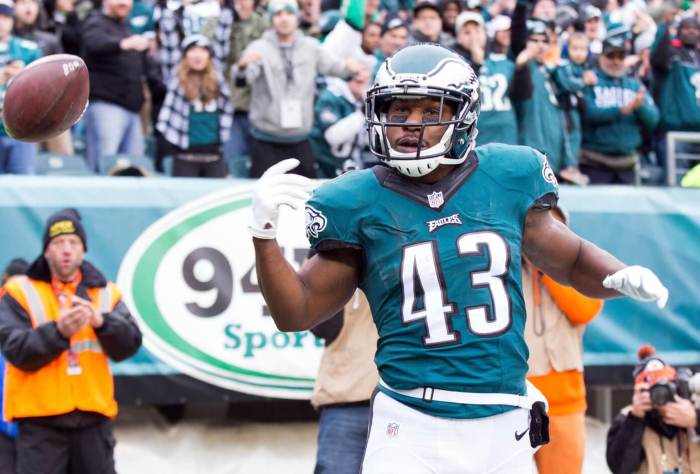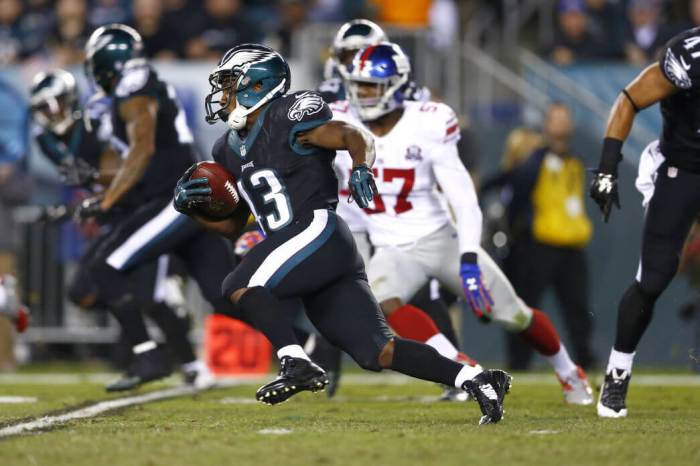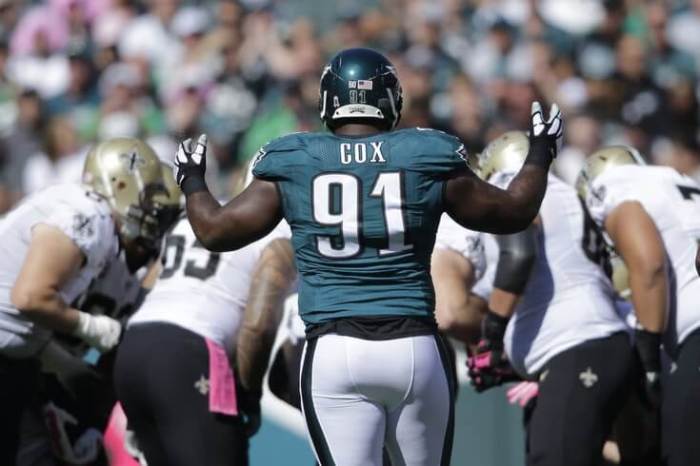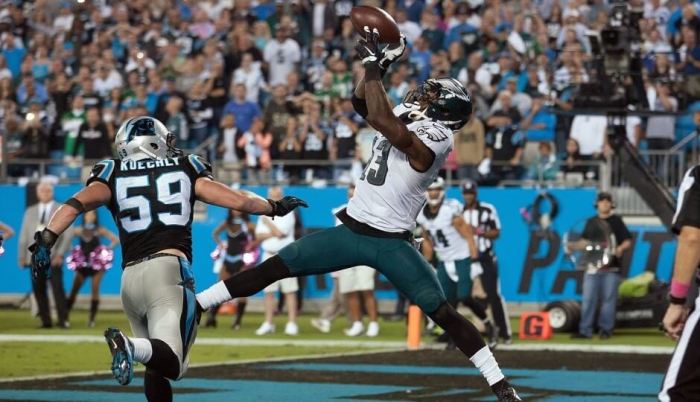If there’s one thing an Offense needs in order to be successful, it’s balance. Coming into the season, it was thought that the incredibly versatile Eagles backfield would be one of the key features in Doug Pederson’s Offense. Factor in that Carson Wentz would be leading the team in his rookie year and the decision to run the ball assertively seemed obvious. But 16 regular season games later and there are now more questions than there were answers looming over the Eagles running backs.
What seemed like a new-found reliance on the lead backs saw the Eagles backfield pose less and less of a threat. Injuries crept in and as opposed to utilizing the many aspects of the backfield, Doug Pederson focused on a lead-back approach. By the end of the year, Ryan Mathews and Darren Sproles combined for 70.4% of Offensive snaps this year. Wendell Smallwood, Kenjon Barner, Byron Marshall and Terrell Watson? Just 30% between them.
Surprisingly, even though Ryan Mathews was once again hampered by injury, he played in just 25.3% of snaps. But the Eagles lead rusher this year played in just about every role. One minute he was a lead back, bursting down Soldier Field for 30 yards and the next, he was a goal-line back as Sproles was force fed the ball and struggled to move the chains at times.
In fact, the entire Eagles backfield struggled to move the chains. The team converted third downs on the ground just 45% of the time this year, 23% less than they did under Chip Kelly just one year ago.
Smallwood and Barner saw less and less of the ball as the season progressed. Smallwood, the Eagles rookie back, was dropped into the Dallas game for his first carry as late as the fourth quarter. This ended in a fumble and some dark questions facing the Eagles Head Coach.
After such a dominating performance against a stern Defense against Pittsburgh, many were excited to see what the Eagles backfield would do next. That excitement turned into anxiety and that anxiety turned into a complete loss of hope. There was no greater sign of the Eagles failure to balance the Offense and the catastrophic effects it can have, than the dismantling handed to them by Cincinnati.
Throwing the ball 46 times, Carson Wentz had little help outside and even less behind him. It’s arguable that the wildly inconsistent backfield’s lack of production could be a byproduct of Lane Johnson’s absence, but the lead rusher in both of their last games rushed for under 50-yards.
Wentz completed a rookie single-season record for most passes attempted..which is probably a sign that this versatile committee effort didn’t pan out as planned. The Eagles also gave Darren Sproles a short-term extension this year, meaning that the team now have Kenjon Barner heading into Free Agency and then a backfield consisting of Ryan Mathews, Darren Sproles, Wendell Smallwood and Byron Marshall.
Ryan Mathews has simply failed to shake the injury label from his name, which is a real shame because when healthy, he can be one of the most electrifying backs in the league and has proved it time and time again. The key to that statement, is “when healthy.” Meanwhile, Darren Sproles is not getting any younger and has already announced that he plans to call it a day after next season. That would leave the Eagles with Wendell Smallwood and an undrafted rookie behind the face of the franchise and a newly bolstered Offensive line.
The fact of the matter is this. It remains to be seen whether Doug actually prefers rushing with a lead back (creating a whole new problem to deal with) or if he can utilize the dynamic backfield as he did as an Offensive Coordinator in Kansas City. But regardless of his preference, Pederson and the front office are going to have to make some tough decisions. Either they roll out with a committee that was reduced to two undrafted rookies and an aging veteran in the latter stages of this season, which could also very likely be the case in years to come, or they decide to move on from a crumbling unit and look to start a fresh.
The unit wasn’t completely ineffective in 2016. The Eagles still put up 1,813 total yards that was good enough to rank 11th in the league. The problem came with a failure to establish a consistent balance or utilize the many styles of back sat on the sideline during a live-game.
Running back talent runs deep in this years draft and the Eagles could absolutely look into drafting a new feature back to build around. Wendell Smallwood flashed in his rookie season and made his case to be part of Pederson’s long-term plans, but the real question becomes do those plans involve a committee backfield?
It’s a question that the Eagles simply have to answer during the offseason. Although the team ranked 10th in total rushing attempts, their nine fumbles ranked them T-6th in the league and their average of 4.1 yards per carry tanked them 18th. Maybe Lane Johnson was all the team needed to execute their perfectly balanced gameplan, or maybe the team need to take a much closer and serious look at the situation emerging in what is a very crowded and very unstable corps of rushers.
What the Eagles are becoming are what the Colts were for Andrew Luck. An inefficient Offense led by an incredibly talented quarterback who was forced to carry the entire franchise on his shoulders. We’ve already seen glimpses of Wentz taking on that responsibility..and the Eagles need to ensure that the load is shared with a rushing attack that can get the job done. Be it committee based, or with the use of one or two backs.
If the Eagles are to have any chance of making it to the promised land, a balanced Offense is an absolute must..and whether it’s down to coaching inefficiencies and sloppy play-calling, a failure to implement the committee attack more often or simply a lack of production from the committee itself, the Eagles have to make some big changes in order to give Carson Wentz and the entire Offense a much bigger chance of success in the years to come.
Mandatory Credit: Bill Streicher-USA TODAY Sports

